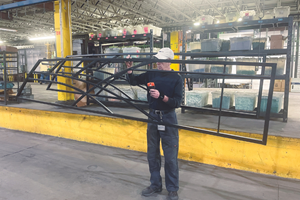Powder Coating Over ECoat
Don’t you have a grounding problem if the part is already e-coated? Is this a relatively new phenomenon? Wouldn’t a powder coating company prefer to pretreat the part themselves to guarantee the powder paint performance?
Q.We make a variety of castings for the automotive industry ranging from aluminum wheels to cast stainless steel exhaust manifolds. One of our products is the subject part—a cast ductile iron damper fork used on the front suspension of select vehicles. The part weighs approximately seven lbs and we have an annual volume of approximately 240,000 parts.
We have to meet a very tough laboratory accelerated corrosion requirement of 10 cycles (each cycle representing one week of salt spray and high humidity combined). We have tried a variety of e-coated products—all of which have failed to meet the rust requirement (0.5% rust at 10 cycles).
Because of a short production lead-time, we have been directed by our customer to now go to powder coating. I have a couple technical questions:
- I have never heard of powder coating an iron part after it is e-coated, although I know BMW does it for some of their high series sheet metal bodies. Don’t you have a grounding problem if the part is already e-coated? Is this a relatively new phenomenon?
- Our current pretreatment does not have a zinc phosphate or iron phosphate pretreatment stage, i.e. we basically clean the part prior to e-coating, not give it a bonding surface. Wouldn’t a powder coating company prefer to pretreat the part themselves to guarantee the powder paint performance? If I were a powder coater, I would be very apprehensive about powder coating over an existing e-coat layer, not knowing the adhesion properties. G.G.
A. Corrosion resistance is primarily achieved by a combination of substrate selection, pretreatment chemicals, occasionally primers and a good topcoat. You can obtain the same corrosion resistance by using these attributes in different combinations or all of them at once, depending upon the particular corrosion requirement.
Since your product substrate is selected for reasons other than corrosion resistance, you must compensate with pretreatment chemicals and primers and topcoats. You may even achieve your corrosion requirements using just the proper pretreatment and a single topcoat. Following is our experience on your substrate (cast ductile iron) with the choices you have available:
No pretreatment and
powder coating topcoat
100+ hours
No pretreatment; e-coat primer
and powder topcoat
100+ hours
Iron phosphate and
powder coating topcoat
500+ hours
Zinc phosphate and
powder coating topcoat
750+ hours
Iron phosphate and e-coat primer and powder coat topcoat
1,500+ hours
Zinc phosphate and ecoat primer and powder coating
2,000+ hours
As I always recommend, you should test your particular selection(s) prior to final implementation.
As for your particular questions:
- E-coated parts have less ground than raw parts. However, since e-coating is relatively thin (a couple of tenths of a mil) the grounding is still sufficient to attract the powder coating topcoat. Many products use both e-coat primers and powder topcoats, so this is not a recent development.
- If your testing reveals that a single powder top coat is all that is required to achieve your desired salt spray resistance, then it would make sense for the powder coating applicator to pretreat the part in their facility. However, if you need an e-coat primer and a powder topcoat, then the pretreatment will have to be applied at the e-coat facility. If your facility does not have this capability, then you may have to install a pretreatment system or subcontract the work.
Related Content
Masking Solutions Provider CFS Dramatically Expands Capabilities and Capacity
Custom Fabrication & Supplies (CFS) completed a new plant expansion packing 10 times the capacity into twice the space. It dramatically enhances the supplier’s custom capabilities to provide extremely precise and cost-effective masking solutions.
Read MorePowder Coating Overcomes Post Forming
Six Sigma methodology, open communication, and collaboration produce results for leading boat manufacturer.
Read MoreProducts Finishing Reveals 2023 Qualifying Top Shops
Each year PF conducts its Top Shops Benchmarking Survey, offering shops a tool to better understand their overall performance in the industry. The program also recognizes shops that meet a set of criteria to qualify as Top Shops.
Read MorePowder Coating 4.0: Smarter, Faster, More Efficient and Connected
New tools reduce cost and waste, lower manufacturing footprint of powder coating operations.
Read MoreRead Next
Episode 45: An Interview with Chandler Mancuso, MacDermid Envio Solutions
Chandler Mancuso, technical director with MacDermid Envio discusses updating your wastewater treatment system and implementing materials recycling solutions to increase efficiencies, control costs and reduce environmental impact.
Read MoreA ‘Clean’ Agenda Offers Unique Presentations in Chicago
The 2024 Parts Cleaning Conference, co-located with the International Manufacturing Technology Show, includes presentations by several speakers who are new to the conference and topics that have not been covered in past editions of this event.
Read MoreEducation Bringing Cleaning to Machining
Debuting new speakers and cleaning technology content during this half-day workshop co-located with IMTS 2024.
Read More













.jpg;maxWidth=300;quality=90)











